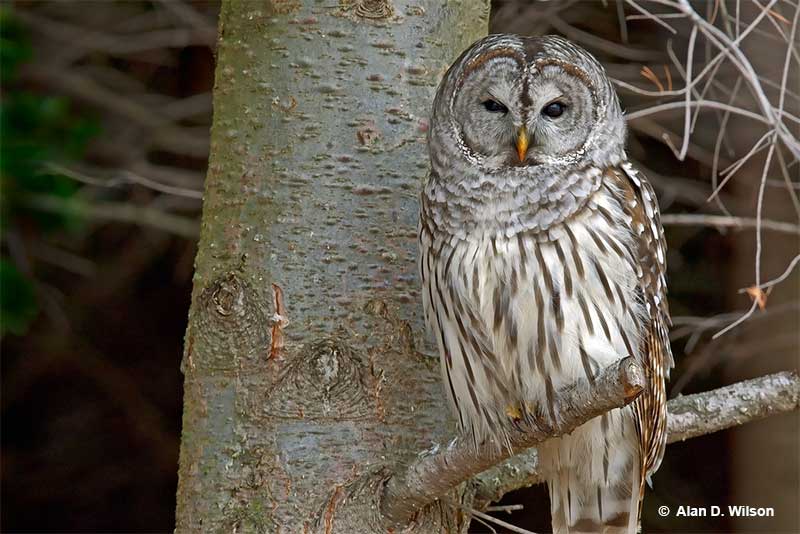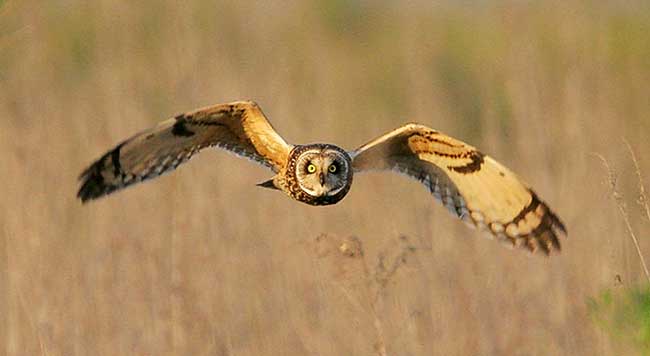
How long do owls live? When I hear owls calling in my neighborhood and nearby nature preserves, I often wonder about that! For years, in wooded areas of upstate New York, I have been hearing different owls calling from the same spots.
I can’t help but wonder if I have been hearing the same birds or their offspring? It’s impossible to say but, after a certain number of years, I figure some of the owls must have died and been replaced by younger birds.
So, how long can owls live? How many of those calling owls are the same individuals? See this article for answers about the lifespans of owls!
On this page
How Long Do Owls Generally Live?
Owls kept in captivity live much longer than birds in the wild. Large owls also tend to live longer than small species.
In general, in the wild, small owls like screech-owls can live for 8 years or so. Pygmy-owls and the tiny Elf Owl are thought to live even less, maybe for just 5 years in the wild! In captivity, screech-owls have lived for 13 to 15 years, and Elf Owls have lived for 14 years.

It’s virtually impossible to tell an owl’s age just by looking at them. This could be a young bird or an old bird.
Medium-sized species like Barred Owls, Short-eared Owls, and Long-eared Owls are believed to live for 10 or 12 years in the wild but can live for 16 or even 20 years in captivity. The biggest owl species in North America, the Great Gray Owls, Snowy Owls, and Great Horned Owls live the longest.
Related: Do owls eat cats?
These big raptors usually live to be around 15 years in the wild, and can live for 30 years or more in captivity!
Owls don’t live as long in the wild because when they get just a bit too old to catch prey, they don’t survive for long. Small owls are also very susceptible to being preyed on by larger owl species.
The life cycle of owls
Like other birds, owls breed during the breeding season. Since it is common for owls to form lasting bonds, the male and female usually stay mated for life. Most owl species have one brood per year; others can have up to three broods a year!
Most owls nest in cavities or nest boxes, but as long as the habitat is suitable for them, the nest sites might vary. For example, Barn Owls prefer old buildings and barns (hence the name), while Burrowing Owls nest on the ground (in burrows).
Owls start preparing for breeding in the winter, and depending on the species, their younglings might have already hatched by mid-April. Owls usually lay their eggs in early March but construct/add to the nest as early as in January. Clutch size varies by species as well, from 1-2 eggs to 10+ eggs.
Incubation depends on the species as well – Great Horned Owls, for example, incubate their eggs around 28-37 days, while smaller Burrowing Owls incubate their eggs for 28-30 days. Once the babies hatch, they are helpless nestlings, but with their parents’ care, they grow stronger with each day.
They stay in the same area as their parents for a few months, and by the following year, most owls have reached sexual maturity and might start the cycle all over.
Can You Tell If An Owl Is Getting Older?
It’s pretty hard to tell if an owl is getting older. Once most owl species reach adulthood, they look pretty much the same for the rest of their lives. However, in the wild, we might not notice when owls get old because once they reach a certain age, they don’t last long.
As soon as an owl gets ill or doesn’t fly as fast on account of its age, it doesn’t catch as much food and probably doesn’t live for another night or two.
However, in captivity, owls don’t have to deal with any problems catching food. They can live much longer than they would have in the wild, and we see some of the effects that aging has on them.
When they are getting older, owls don’t fly as fast or as agile as they used to. In captivity, we see this with owls spending a lot more time resting than moving around. Their feathers also tend to look more worn and can fall out. As they get older, owls can also develop cataracts and other eye problems.
Related: Are there any featherless owls?
At this point, the owl is pretty old and can still live, but only by feeding the bird and taking care of it.
Fun Facts About Owls And Their Lifespan
- The Eurasian Eagle-Owl lives longer than most other owl species. In captivity, one bird lived for more than 60 years!
- In North America, the owl with the longest lifespan is the Great Horned Owl. In the wild, these big raptors can live more than 25 years. In captivity, one bird lived to be nearly 50.
- The owl with the shortest lifespan is the pygmy-owl. There are many species of pygmy-owls and not much is actually known about most of their lifespans. However, pygmy-owls in captivity tend to only live for three to five years.
- Many owls don’t live past their first year of life. In common with other raptors, after leaving the nest, they have to learn how to hunt as quickly as possible while also avoiding more experienced, larger birds of prey.
- Barn Owls live around 4 to 9 years in the wild. Since they can eat 1,000 rodents in a year, one Barn Owl could eat anywhere from 4,000 to 9,000 mice and rats during its lifetime!
- Some of the main predators of owls are other owls! Many owls prey on smaller owl species. They catch and eat smaller owls for food while also eliminating competition.
- In general, owls feed on mammals and reptiles, sometimes even amphibians. The bigger the owl, the bigger prey it can catch, but in general, owls go for rabbits, voles, shrews, mice, and other small rodents, plus snakes, frogs, lizards, and the list goes on. However, they do not digest the bones and fur of the animals. These come out as owl pellets.
- Some owls store dead mice and other animals that they catch and kill. They do this to have an emergency food source in case prey becomes scarce.
Frequently Asked Questions
What is the longest lifespan of an owl?
The longest lifespan of an owl is that of the Eurasian Eagle Owl. Some eagle-owls in captivity have lived for more than 65 years!
What is the average lifespan of an owl?
How long an owl lives depends on the species, but most owls usually live at least 5 years. After that, it depends largely on the species – for example, larger owls live around 12 years, and even longer in captivity.
Do owls mate for life?
Yes, most owls do mate for life. However, if an owl’s mate dies, they might find another mate.

